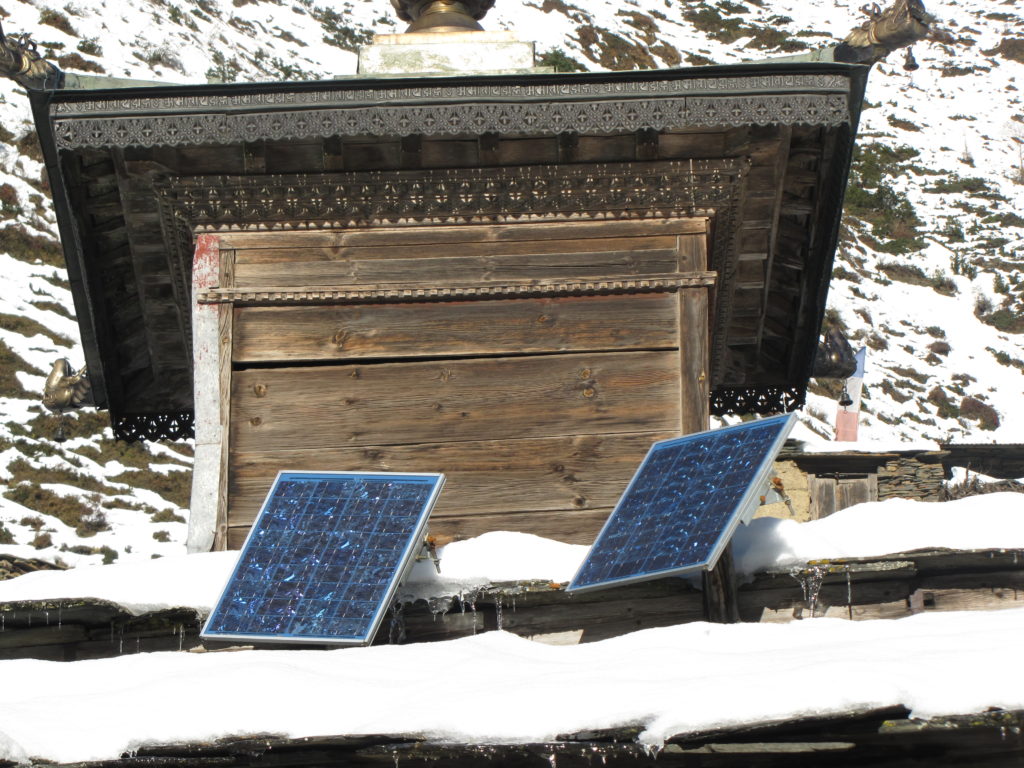The start of the trail towards Mu Gompa is pleasantly flat, so you can focus more on the unfolding beauty around you. As we were well into the middle of autumn, in October, and at a relatively high altitude, the further we went, the more bleached the trees at the foothills became, in different shades of red and yellow. The first glaciers touching the valley floor could be seen, right up to the fields. This is ‘Gompa’ country, with some small monasteries tucked away under protruding rock on the cliff face. The sky remained a clear blue as it got warmer. A lot more familiar Buddhist features were prominent, at some points with hundreds of prayer tablets. We dipped down to the riverbank, taking a faster bankside route thus avoiding the villages of Chho and Nyile. A number of trekking groups trekked all the way to these villages the night we were in Phule, in order to take a day trip to Mu Gompa. I would not recommend that. It is unnecessary extra walking resulting in less of the desired cultural experience of family and monastic life.

The high peaks of the valley were now intimidatingly right above us. So vivid, and ironically ‘Tsum’ means vivid. It became more open grassland dotted with grazing yaks, fearlessly seeking tastier pastures, walking over glaciers to get to the juiciest bits. We too had to walk over several glaciers and luckily the snow from the storm of days ago had since melted. It is easy to discern recent snowmelt from the dirtier, pebble pockmarked glacial continuum. The incline up to Mu Gompa, at 3700m in altitude, had begun. The sun drenched snow capped peaks gleamed all around us in a 360 degree panorama. This rugged wilderness was interrupted by power lines coming from a hydroelectric turbine room, which then released water into the river. There were still sections of the valley that remained frozen because of absence of sunlight. Apart from the occasional yaks and sparse birdlife, the only things that stirred were rolling snowballs as they melted.
We were the first to arrive at Mu Gompa Monastery, at midday, and it turned out that we were the only ones staying over that night. We had the whole afternoon to enjoy the winter wonderland. To show how cold it can get, the roof eaves that were not exposed to the sun had icicles suspended off of them. We were greeted by the Lama (otherwise known as the chief monk or guru) and then proceeded to have dal bhat as other trekkers who were day-tripping streamed in. The main courtyard is dominated by the temple. There are plenty of rooms here, arranged like army barracks in rows going up a slope. In the colder periods there are less monks resident there. A few wondered towards us to say hi and enquire about where we are from. The numbers can range from 7 to 30 monks. The accommodation offers scope for summer schools, retreats and conferences. The slope itself sits on a sheltered narrowing of the valley where any wind arriving is broken and weakened by the numerous peaks around us.
When I got up the sun, which had gone missing in the peaks behind us was only bathing the tops of the peaks on the opposite side of my view across the narrow valley. The temperature drop was already being felt. There was going to be no more snow melt today. We started layering up and preparing the sleeping bags for a chilly night. After dusk we hung out in the kitchen with our guide, the porters and monastery chefs listening to Nepali pop on the radio. Dinner was quite lonesome in the large dining hall. The only thing left was to use the soup and dal bhat heat to observe the stars before a hasty retreat into sleeping bag paradise.
We had breakfast in the courtyard to catch the heat rays of the early sun. A big bowl of ”tsampa” (buckwheat) porridge, chapati and tea with the gentle hum of morning prayers in the temple. After some photo opportunities and jovial banter with the monks, who had just completed their morningpooja, we left the monastic hideout.

